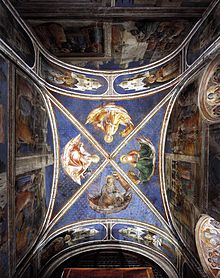Cappella Niccolina
The Cappella Niccolina (Nicholas Chapel) is a chapel in the core of the Vatican Palace . It is located there together with the Raphael Rooms and is now part of the Vatican Museums .
history
The palace core was built in the 13th century under Innocent III. and was later completed by Nicholas V as a four-wing complex. The Cappella Niccolina, named after Nicholas V, is dedicated to the archdeacons Stephen and Laurentius , who were venerated in Rome, and was painted by Fra Angelico , who is counted among the most important artists of his time, with the help of Benozzo Gozzoli from 1447 to 1449. The Nikolauskapelle is the only remaining chapel Fra Angelico, whereby only 3 walls are preserved. The altar on the south wall was lost. According to Giorgio Vasari , the burial of Christ was depicted there, but this can no longer be proven.
Image program
The walls of the chapel are laid out in two registers, each showing six scenes from the lives of the saints. The Stephanus cycle is in the upper register, which consists of three lunettes. The Laurentius cycle is below in the register, but consists of rectangular image fields and thus has clear priority over the Stephen cycle. In addition, the vault of the chapel shows the 4 evangelists .
Stephen cycle
- Scene: Stephen is installed as a deacon (Acts 6–7)
- Scene: Stephen as a preacher, unwilling listeners in the background, Stephen's speech
- Scene: Stephen is pushed in front of the city walls of Jerusalem and stoned, Saul holds the clothes of the stoners.
With this cycle of images, Stephen is presented as the first of all martyrs , so to speak as a “proto-martyr”.
Laurentius cycle
- Scene: Laurentius is installed as a deacon by Sixtus II. Sixtus II is surrounded by three priests, two deacons and three sub-deacons are also present (different ranks or degrees of ordination of the church are represented).
- Scene: Laurentius takes over the church treasure from Sixtus II to distribute it to the poor so that the treasure does not fall into the hands of the emperor, Laurentius distributes the treasure.
- Scene: Presentation of Laurentius, reference to the torture device rust, torture of Laurentius to death.
In general, three main aspects of the picture cycle can be mentioned, which derive their legitimation from the Bible and refer to their topicality:
- The cycle of paintings by Stephanus and Laurentius puts emphasis on the priority of Rome as a valid capital over Constantinople and Jerusalem.
- The Pope is declared to be the direct successor of Peter by comparing the upper and lower register.
- The emphasis on Peter (he consecrates Stephen), he stands above the other apostles.
The historical background for understanding the picture cycles is the convening of the council in 1431 by Eugene IV , which had the aim of reforming the church. In 1439 Felix V was elected antipope and was only forced to abdicate 10 years later.
In the picture cycle of the Cappella Niccolina, the ideals of the church are presented in the form of Stephanus and Laurentius, the service at the word of the Pope, with the aim of underlining the position of the Pope as the absolute head of the Church and the work of the Church in solidarity and authority underline.
Web links
- Description of the chapel on the Vatican Museums website
- View of the west wall
- View of the north wall
- View of the east wall
Coordinates: 41 ° 54 ′ 12.2 " N , 12 ° 27 ′ 16.6" E



